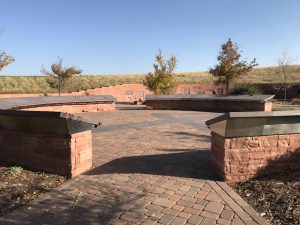Eery. Strange. Nothing but evil.
These are my descriptions of an historical site, the one site out of the many I’ve visited over the years that I’ll say, with no hesitation, is the most eery, the strangest, and as a place of significance is filled top to bottom with nothing other than pure evil.
Not Hitler’s vacation hideaway, not the Nazi’s model concentration camp at Dachau, not the slave trading site of Charleston, South Carolina, not New York City’s Ground Zero or Shanksville, Pennsylvania’s United 93 crash site of September 11. Not these.
But instead: Columbine High School in Littleton, Colorado.
The place in the photo remembers the events of April 20, 1999. That’s when two young killers terrorized their own school. They had plans—they had dreams—of killing hundreds of more people. They gunned down a teacher and twelve classmates. Thirteen victims dead. And then they killed themselves.
My wife, our two daughters, and I visited the memorial on an early fall day in 2017. We followed the sidewalk on a gently rising curve. This was a side trip, added-on at the last second while driving from a hiking trail back to our hotel in downtown Denver.
I’ll never forget the site as long as I live.
It was as out of place and out of sync as a spaceship, left empty by vanishing creatures who were now twenty galaxies away. Alien.
I say this not about the young students and teacher murdered by the pair of savages. They were all too familiar, to you and to me. No, I invoke “alien” to show how out of reality this monument ought to have been.
Here is what we heard on that visit: a school band playing, the ping of aluminum bats in a baseball game, distant sounds of clapping and laughter, the motor of a car picking up or dropping off kids.
Here is what we saw on that visit: names cut into stone, sentences of memories cut into stone, words of love cut into stone. And thin stems of dead flowers laid across the slabs of stone.
The contrast between sight and sound was numbing. The contrast deepened my sense of the past of the place; a single second of time marked the shift from the ordinary present of a school day and the hideous start of a slaughter. In any of the seconds it took for the beats of my heart, that same thread of time suspended life from death on that April day.
I don’t see these stones except at cemeteries. At family plots. At battlefields. At old famous houses or estates. At scenes of some great struggle etched in the public mind.
But not like here and not like this. At Gettysburg you can find out why. At Normandy and Hiroshima, you can find out why. At Rome, in the Coliseum, you can find out why. At Ground Zero and Pompeii, you can find out why. Above the watery graves of sunken ships, you can find out why.
The “why’s” of these places aren’t simple or clear-cut. They don’t always produce agreement among visitors. But at least you’re able to decipher a reason behind what happened. Even the worst deeds of dictators and terrorists will have a why to them. You won’t like it perhaps, but it’s there.
At Columbine there is no why. The closest you’ll come to a why is a form of severe mental illness or life-threatening mental disorder. Somehow, that doesn’t do it. That doesn’t change the alien of the thing. It only makes it more opaque.
I wondered about something during our visit. Among the many things I learned on the memorial walls was this: that its design was a local, private effort. The families of victims, along with others deeply affected by the event, joined together to help conceive of, design, and underwrite the site. An elaborate process—including hundreds of people over roughly four years—resulted in the memorial’s opening in 2007. I stood in awe of their work. I left there with the feeling that the memorial-makers would have wanted me to have—that the alien nature of the event and its perpetrators did not overshadow the humanity of the thirteen people killed there.
I wonder now if, how, when, and where such an incredible memorial could be achieved again in the United States. Are we up to it a decade later? I hope so, but I’m not so sure.
The past is everything before now. History is a partial subset of the total past, the pieces that, for varying reasons, we choose to remember, recall, and retell. At the Columbine Memorial, where a history has sprung from the past, you will find a site like none you’ve seen before.








